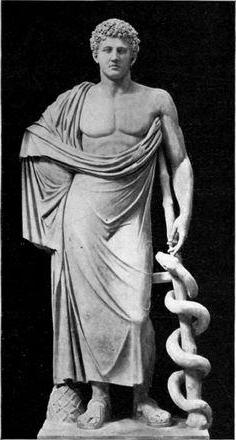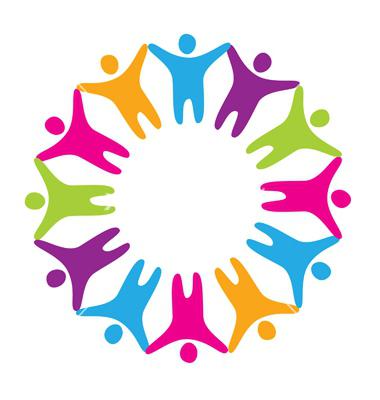Everyone knows that the symbol of medicine is a bowl witha snake, and in the people it is jokingly called "mother-in-law eating ice cream." But that means such an emblem, not everyone knows. What else are the symbols for medicine, where did they come from and what is their true meaning? That is what we will discuss in our article.
Where did the medical symbols come from?
At different times, different cultures have taken theirThe symbols and emblems of medicine, which reflected the understanding and perception of death and life, indicated the image of the healer and the methods of treatment. Speaking of various medical symbols, it is worth remembering the famous gods - patrons of healing, ancient methods of treatment and other features.
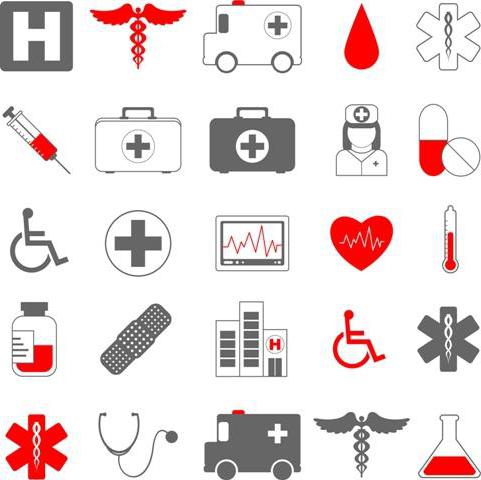
The most basic and most ancient symbol of medicine -snakes. It is their image in various forms that was used to refer to healing. The history of using this sign goes back to the ancient civilizations of the East, Greece and Egypt. For example, it is the snake that wraps around the body of Isis, the Egyptian patroness of healing. Also, the snake is accompanied by an inscription on the pole of Sesostris I in Karnak, where it is said: "I bestow life, longevity and health ... on the king of lower and upper Egypt." Interestingly, the modern symbol of medicine is also not without a snake image. Here the reptile wraps the bowl, and each of the parts of this emblem deserves special attention.
With the development of society, with increasing levelsknowledge of nature and the world around us, the symbols reflecting various phenomena have been changed and rethought. Today, the interpretation of extant symbols of healing is quite diverse. There are about fifty different conventional images, meaning medicine, but we consider only the most common.
General and private healing emblems
For a comprehensive study of the issue, along with many scientific methods used in the study of medical symbolism, the historical method is also relevant.
The most valuable sources for studying the issueare numismatics and bonistics. The first examines coins, tokens, medals and orders, and the second examines paper moneys in historical, economic and artistic aspects. It is on the coins and banknotes of various epochs that the greatest number of medical symbols and emblems of healing can be found, and in some cases it is generally the only source of confirmation of their physical existence.
Specialists who study the emblems and symbols of medicine tend to apply a special classification, according to which all existing designations can be divided into private and general. To private include:
- a drop of blood is a sign of a surgical profile;
- image of lily of the valley;
- klister (enema);
- pulse hand - therapists' emblem;
- image of the Florentine baby;
- pentagrams of surgical instruments, such as a scalpel;
- urinarium;
- mortars with or without a pestle — these emblems are used by pharmacists or medical societies;
- military medical signs (emblems).

- snake;
- the staff of Asclepius (Aesculapius) - a snake twining a stick;
- snake around the bowl;
- two snakes twisting the rod of Hermes (Mercury);
- egg;
- a snake twirling the Apollo tripod;
- lamp;
- impotekhok ank;
- serpent winding mirror;
- cock;
- one or two snakes swirling around a candle or lamp;
- snake wrapping around the Delphic navel, omphalos;
- a burning candle or torch;
- heart in the palms and others.
Thus, we can conclude that general symbols mean healing in general, and private ones are meant to divide medicine in directions.
Why snake is a symbol of medicine
At the dawn of civilization, justthe emerging primitive society, when the first totems reflected the helplessness of man in nature and the world around him, the serpent was one of the main symbols. With the advent of the religious cult, the dual nature of good and evil was attributed to snakes. On the one hand, they personified treachery and cunning, and on the other hand, they were a symbol of wisdom, knowledge and immortality.
Interesting, but in ancient beliefs symbolMedicine was not a poisonous snake, but a quiet, harmless one. That they were called "Aesculapian snakes." These reptiles were honorary residents of cult healing centers in Rome and Greece. The snakes moved freely around the house and healed the sick who licked - they licked their wounds. The Romans and Greeks loved their snakes very much, kept them in houses, baths and baths.
For many nations, the snake symbolizes a good start, brings prosperity to home, health and happiness to those living in it. Also, according to belief, snakes heal wounds and are able to teach the wisdom of healing.
In ancient oriental mythology, the snake alsoassociated with the health of people and their treatment, and in African countries personified healing. Perhaps this is the only case in which you can trace the chain of associations. The fact is that in Africa only sorcerers were engaged in treating people, they were also spellcasters of poisonous snakes. And so a chain of associations appeared: sorcerer - snakes - treatment. Then, however, the sorcerers disappeared somewhere, but the snakes and healing remained in a strong bundle.
В европейских странах, в отличие от Африки, змея was associated not with sorcerers, but with wisdom and knowledge in general. This is a symbol of eternal youth - in this case, rejuvenation is symbolized by an annual moult, skin change. This ability of the snake in the literal sense of the word "go out of yourself" has found an interesting reflection in Egyptian legends. At midnight, the great sun god Ra, along with his entourage, emerges from the luminous boat and enters the body of a huge serpent. In the morning, all of them go out of his guts as children, get into the sacred boat again and continue their journey across the sky. That is, according to the ancient Egyptians, the day gives way to night.
Similar myths of rejuvenation and immortality existin African tales, Sumerian legends and Greek myths. As the oldest symbol of medicine, the snake was depicted without any additions and attributes. And only much later the staff, tripod, mirror, or the famous chalice began to be attached to it.

What does the bowl symbolize?
Since the symbol of medicine is a bowl with a snake,the next thing we’ll talk about is she. The most common interpretation of the fact that it was the bowl that became the symbol of something good and saving, that is, medicine, is associated with the perception of fresh water in arid regions of the globe. Since it rained rarely in these places, the water became a gift from heaven. It was possible to save the gift of the heavenly gods with the help of hands folded in the form of a bowl, or stones with grooves, clay or metal utensils. Since people died out of drought in whole villages, prayers for rain began to be accompanied by requests for health and the preservation of life. On the ancient Egyptian steles and frescoes, the patient, addressing the gods with a request for recovery, holds the cup in her hands.
Treatment with water has become traditional forcountries of the Ancient East and India. Alchemists must have used water or dew drops to produce drugs. Special cups with spells and symbols engraved on them were used for healing. For example, for the treatment of fear (the “disease of fear”), Muslims used a special “fear cup” - a copper bowl specially made in Mecca and decorated with sayings from the holy Quran.
Народные сказания до наших времён сохранили expressions associated with ritual bowls: “the cup of suffering”, “let the house become a full cup”, “drink the cup to the bottom”, “bowl of patience” and others. In these sayings lies the dual nature of the image - the double-sided cup, the creation of heaven and earth. If a person drank from the cup of earthly creation, his gut refers to earthly passions. Having drunk from the celestial cup, a man directs his thoughts to heaven, lofty ideals, gets rid of earthly sins and passions. Not for nothing one of the symbols of Christianity is the Communion Cup - the cup of deliverance from sins.
Staff
Considering the symbols of medicine, it is impossible notwe can also recall the staff, the bough pole, around which a snake is usually twisted. This item personifies the road stick, meaning the travels of the healers. The staff not only helps along the way, but also increases the level of trust. Medical treatises in India strongly recommended the doctor to have a staff with him, as patients unconsciously trust more people to experienced, elderly, having a connection with the ground.
It is this object and became the prototype of the canedoctor, especially popular in England in the Middle Ages. Sometimes as a medical symbol, the staff was depicted with branches and foliage. This symbolized the beginning of a new life, rejuvenation.
In some emblems there is not a staff, butthe rod of Mercury, or Hermes. This god was considered an intermediary between the realms of the dead and the living, between humans and gods. According to legend, Hermes received his rod as a gift from Apollo. It was a reward for the fact that he invented such a musical instrument as a lyre, and played it masterly. The Greeks called this magic cane Kyrekiyion, and the Romans called caduceus.
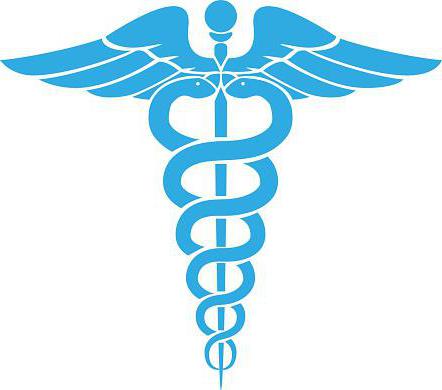
Pentagram and Tripod
Such symbols of medicine as the pentagram and the tripod of Apollo are also quite popular.
Первый из них — пятиконечная звезда, нарисованная one line. This sign is rooted in Mesopotamia and Egypt. It is believed that the five planets known by that time were thus interconnected: Mars, Venus, Saturn, Mercury and Jupiter. This symbol was most often used as a talisman and amulet against spirits and creatures that cause unhappiness and disease. A little later, during the widespread spread of Christianity, the pentagram became a sign of heretics and was replaced by an image of a hand with fingers spread.
The second sign is the Apollo tripod.According to legend, at the foot of Mount Parnassus Apollo killed Pithon, the evil monster guarding the valley. The Delphic temple, the sanctuary of Apollo, was built at the site of the battle. One of the walls of the temple was a rock, from the crevice of which a heady aroma flowed. Nearby, on a golden tripod, sat the Pythia, a priestess who communicated with the gods and thus recognized their will. And since Apollo was the patron saint of medicine and healing, the tripod from his sanctuary became a special symbol uniting the three principles of medicine:
- own observation;
- analysis of other people's observations;
- conclusion by analogy.
Staff of Asclepius
Итак, что означает символ медицины, изображающий stick up by which the snake crawls? For a start it is worth noting that this sign is most recognizable from about the VIII century BC. The history of this sign goes back to the Greek myths. According to legend, Asclepius (the Romans called him Esculapius) learned his art, the art of healing, from a centaur named Chiron. He successfully applied his knowledge in practice and became a master healer. He treated people so well that Zeus was afraid that, thanks to his efforts, people would become immortal altogether. Therefore, he killed Asclepius with a thunderbolt.
There is a legend that onceAsclepius was invited to the court of King Minos to resurrect his dead son. On the way to the palace, a serpent suddenly climbed onto a stick on which Asclepius leaned while walking. The doctor was scared and killed her. As soon as he deprived the reptile of life, another serpent appeared out of nowhere, carrying grass in its mouth. With the help of a bunch of grass, the snake resurrected his girlfriend, and together they crawled away. Asclepius correctly understood the sign of the gods, he found the grass that was kept in the mouth of the serpent, and was able to resurrect the son of King Minos.
Since then, the image of the staff of Asclepius was used as a symbol of healing, and the doctor himself was worshiped as the god of healing.
Bowl with a snake
However, much more commonThe symbol of medicine is the snake around the cup. The first images of this symbol refer to 600–800. BC. It is noteworthy that at the beginning the parts of the image existed separately and were attributes of Hygea, the daughter of Asclepius — she held the snake in one hand and the bowl in the other. And only much later images merged into a single whole.
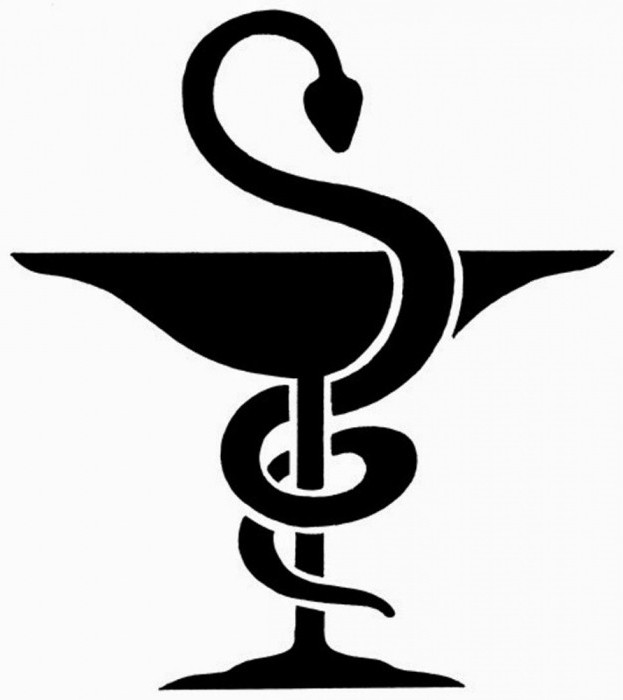
Истинное значение этого знака весьма спорно.Someone interprets it this way, and someone else. Most often the cup is associated with the capacity to store snake venom, a well-known medicinal substance, and the snake symbolizes wisdom. However, there is another interpretation. According to him, the emblem reminds the doctor of the need to be wise, and to draw wisdom from the cup of world knowledge, the human mind encompassing the whole world.
The most fun interpretation of the symbol came up with medical students. In their opinion, the symbol means that the physician is "cunning as a snake, and loves to drink very much."
Today, such an emblem is most often used to denote pharmaceutical activity.
Caduceus
The meaning of the symbol of medicine, depicting a rod with wings, around which two snakes hover, is also not very clear.
The fact is that caduceus was originally a symbol of secrecy, a sign protecting commercial or political correspondence. And only much later became the symbol of medicine.
For convenience of perception, it is worthwhile to divide the emblem into several parts:
- the rod symbolizes the Tree of Life, the connection between heaven and earth;
- the double helix formed by the interweaving of serpentine bodies is a symbol of cosmic energy, the unity of opposites, the duality of phenomena;
- The reptiles themselves are the active forces of the earthly and otherworldly worlds.
Most likely, the transformation of a symbol from a commercial (political) to a medical one was due to the presence of snakes, which simultaneously provide both a therapeutic drug and poison.
Red Cross and Crescent

Similar meanings are:
- Red Cross;
- red crescent (in Islamic countries);
- sun and red lion (in Iran);
- red star of david (in israel).
At the present time, the Red Cross Movement is engaged in the development of new symbols, devoid of national and religious signs.
Star of life
Символ медицины, фото которого представлено ниже, not too popular in Russia. This "Star of Life" - a symbol of medicine, born in the United States. Each of the rays of the snowflake symbolizes a certain function of emergency medical care:
- detection;
- notice;
- response;
- assistance at the scene;
- help with transportation;
- transportation for further assistance.

Conclusion
Studying medicine is impossible not to know or notunderstand the characters meaning healing. Interest in the past, as is known, gives rise to a bright future. The brighter we can imagine the content and significance of the cultural relay passed on to us by past generations, the more valuable and meaningful the present becomes for us. Indeed, in each symbol, our ancestors put a special meaning, designed to convey its value to future generations.




